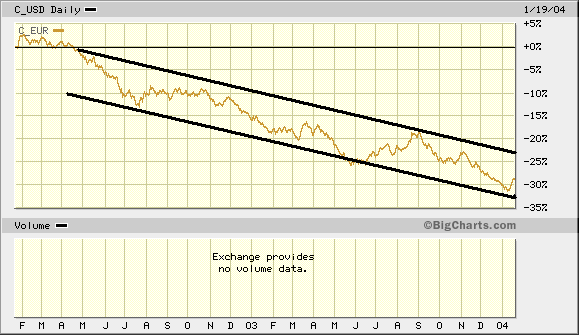Eurotrashing the Dollar
A lot of dollar bashing went on at Brown’s Restaurant last night. Your editor participated, of course, setting aside my patriotism for common sense. But I asked the mostly U.K. dinner party what made the Euro any “sexier” than the dollar, or at the very least, less ugly. “The euro isn’t ‘sexy’ at all, and that’s just the point. It’s a much more prudently managed currency. Just because the ECB doesn’t follow the daft nonsense of Sir Alan Greenspan doesn’t mean the currency is inferior.” But every paper currency is ugly in its own way. And every paper currency is inferior to gold, in the long run. The long run is a very long time, however. And in the meantime, central bankers and traders are sounding like they just wish the whole business would settle down to something predictable. Here’s a question that came in the e-mail today: Dear Daniel, As you can imagine I was surprised to see last weeks USD "resurgence". While I did anticipate to see regular mild corrections in the value of the USD, the speed and range of the retracement has surprised me, considering that the fundamentals haven't changed. The whole thing seems to have been triggered by comments from several ECB officials. I would greatly appreciate it, if you would be kind enough to give me your view on this subject. The comments that struck me as most absurd in the last week were those by ECB president Jean-Claude Trichet. He said he was "concerned" by "excess volatility and brutal moves in the euro.” Tut-tutting even more, he said these moves were "not welcome and not appropriate." Not welcome, maybe. But not appropriate? This is the problem with tying to manage a currency. It’s not an “orderly” process. The market identifies a level where it thinks the currency is fairly valued and it shoots directly to it. The adjustments are happening quickly now, in a matter of days not weeks. Intervention by central banks, as in Japan, can slow this down a little. But it can’t stop it. And so short-term, the dollar was probably over-sold, the ECB mouthed off about it, and traders took some profits. The dollar trade, after all, isn’t exactly a secret anymore. It fact, it’s almost conventional wisdom now that the dollar is overvalued, interest rates will rise, and bonds will be crushed. The truth is, this could take a very, very, very long time. Interest rates may not rise at all this year, and certainly not until after the election. The Fed doesn’t have to defend the dollar if nobody is selling it. And nobody seems that interested in selling the dollar. Nobody at all. As long as purchasing power doesn’t decline noticeably, American consumers don’t care. Goods from China are still cheap. If energy prices rise…they might start to care. But right now, not a worry. Europe doesn’t want to sell the dollar. It wants to buy it, to support the dollar so the euro doesn’t rise to damaging new highs that hurt the competitiveness of Eurozone exporters. Last week's kvetching caused the euro to finally weaken from its all-time high of nearly $1.29 on Jan. 12. It’s lost about 4% since then. Japan doesn’t want to sell the dollar. It wants to buy it too…and has been to the tune of about 30 billion yet last week. Nobody wants to sell the dollar. And so the dollar rallied for a spell. But at the open this morning here in London, the euro jumped a full one percent from yesterday’s close of $1.2349 to $1.2486. This, after EU finance ministers passed on a chance to trash their currency and instead said they had “no view.” Well of course they have a view. And even now they’re probably regretting not saying something banal and vaguely menacing about the U.S. twin deficits. And THAT, of course, is the root of all dollar evil. The currency may have periodic bouts of strength. But this is illusory strength. Or better, only relative strength. It’s strength only in the sense that other central banks want to have more competitive currencies and do so by making those currencies “weaker” relative to the dollar. Check out the chart below. It tells the story of the last two years between the euro and the dollar. The price channel is down. The recent dollar strength moved the trend line back towards the middle of the channel. Conceivably, the dollar could rally all the way back to $1.20 and still be in the downward channel. Or, it could simply hit the halfway point and move back down…testing new lows this spring. How long will this last? Will something snap and put the dollar in free fall? These are questions I’ll be taking on all winter….


0 Comments:
Post a Comment
<< Home